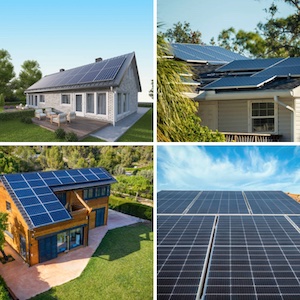Upgrading Your Solar System
Upgrading Your Solar System: Powering Your Home Efficiently
As electricity costs rise and load-shedding remains a reality, upgrading your residential solar system is a smart move to boost energy independence and cut bills. Whether you’re starting with a modest setup or expanding an existing one, a well-planned upgrade can meet more of your household’s daily needs. Let’s explore how to build a system covering 50% of a typical 25-30 kWh daily usage (60% daytime, 40% nighttime) and then scale it to handle 80%, using popular components for practical, real-world results.
Building a Starter Solar System
For a household using 25-30 kWh daily, with 60% (15-18 kWh) consumed during the day and 40% (10-12 kWh) at night, a system meeting 50% of this demand needs to generate and store about 12.5-15 kWh. Here’s a practical setup using widely trusted components:
- PV Panels: 8 x 550W monocrystalline panels (e.g., JA Solar or Canadian Solar). Total capacity: 4.4 kW, producing ~17.6 kWh daily with 4 peak sun hours.
- Inverter: 5 kW hybrid inverter (e.g., Sunsynk or Deye), handling both grid-tied and off-grid modes for flexibility during outages.
- Battery: 5.12 kWh lithium-ion battery (e.g., Pylontech or BYD). Stores ~4.8 kWh usable energy for nighttime use.
This system generates enough daytime power to cover most of the 15-18 kWh daytime usage, with the battery supplying ~40% of the 10-12 kWh nighttime needs. Excess daytime solar offsets grid reliance, and the hybrid inverter ensures seamless switching during load-shedding. Expect to spend R80,000-R100,000, depending on installation and accessories, with payback in 5-7 years at current tariffs.
Scaling Up for Greater Coverage
To upgrade this system to meet 80% of your 25-30 kWh daily usage (20-24 kWh), you need to generate and store more energy without overhauling the core setup. Horizontal expansion—adding compatible components—keeps costs down and leverages existing infrastructure. Here’s how to do it:
- Add PV Panels: Install 4 more 550W panels, increasing capacity to 6.6 kW. This boosts daily output to ~26.4 kWh, covering daytime needs and charging batteries.
- Expand Battery Storage: Add another 5.12 kWh battery, doubling storage to ~9.6 kWh usable. This handles 80-90% of nighttime demand.
- Inverter Compatibility: The 5 kW Sunsynk/Deye inverter typically supports up to 6.5-7 kW of PV input, so no upgrade is needed unless you plan further expansion.
This upgrade pushes solar contribution to ~20-22 kWh daily, hitting the 80% target. The extra panels cost ~R20,000, and the additional battery ~R30,000, totaling R50,000-R60,000. The expanded system maximizes self-consumption, reduces grid dependence, and shortens payback by increasing savings.
Practical Tips for a Successful Upgrade
Before upgrading, assess your setup and goals to ensure efficiency and longevity. First, check your inverter’s capacity—most 5 kW hybrids handle moderate PV increases, but confirm specs to avoid bottlenecks. Monitor usage patterns with a smart meter to fine-tune panel and battery sizing. For installation, use accredited professionals to maintain warranties and comply with local regulations. Regular maintenance, like cleaning panels and checking battery health, keeps performance optimal.
Upgrading your solar system is a balance of cost, capacity, and practicality. Starting with a 4.4 kW, 5 kWh setup covers half your needs, while adding panels and storage scales to 80% coverage without major rework. With popular components like JA Solar panels, Sunsynk inverters, and Pylontech batteries, you’re investing in reliable, expandable technology that delivers power and peace of mind for years.
Where Are You In Your Solar Journey
Researching

Ready For Quotes

Already Installed

Contact Us
Contact
+27 (0) 71 087 6723
info@solarcentral.co.za
Address
210 Amarand Avenue, Waterkloof Glen
Pretoria, South Africa
Schedule
24 Hours / 7 Days Open
Office time: 10 AM - 5:30 PM
Platform
get in touch
Ready to Get Started
Please fill out this form and we will get in touch with you shortly.
